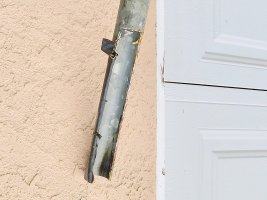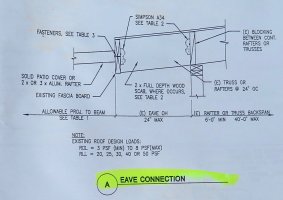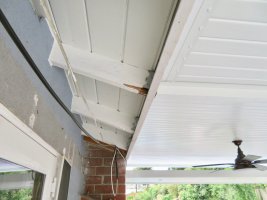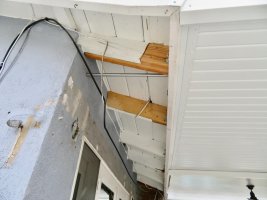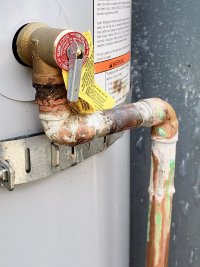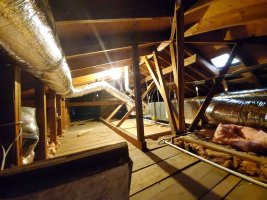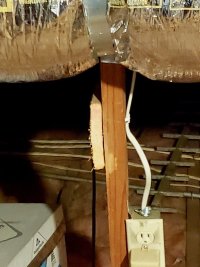-
Welcome to The Building Code Forum
Your premier resource for building code knowledge.
This forum remains free to the public thanks to the generous support of our Sawhorse Members and Corporate Sponsors. Their contributions help keep this community thriving and accessible.
Want enhanced access to expert discussions and exclusive features? Learn more about the benefits here.
Ready to upgrade? Log in and upgrade now.
You are using an out of date browser. It may not display this or other websites correctly.
You should upgrade or use an alternative browser.
You should upgrade or use an alternative browser.
An average day
- Thread starter ICE
- Start date
The drywall was removed and the conduit was cut open to expose the service entrance conductors.
Im sure they pulled the meter before cutting into the conduit full of live wires. Thats desparate.
The wires are before the meter and live with or without a meter installed.Im sure they pulled the meter before cutting into the conduit full of live wires. Thats desparate.
There was a service panel upgrade associated with a solar project. I had to verify a jumper between the hot, cold, and gas pipes at the water heater. I found this:
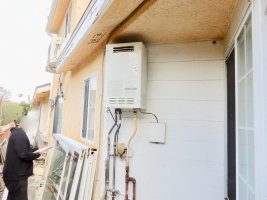
There was no doubt that it was dangerous so I made the owner move it ....or so I thought. Instead of moving the tankless water heater he replaced it with a storage tank water heater. The water heater is now too close to a property line.
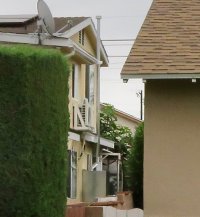
I just don't understand why people don't give these things room to breath.
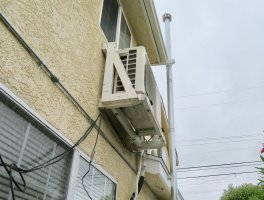

There was no doubt that it was dangerous so I made the owner move it ....or so I thought. Instead of moving the tankless water heater he replaced it with a storage tank water heater. The water heater is now too close to a property line.

I just don't understand why people don't give these things room to breath.

Last edited:
It was left like this for hours with the workman sitting in a van at the street. He couldn't see it. Not only are the covers off but the door is open wide. There are small to medium size children living there. The workman told me that he alerted the housewife of the danger. He said that inspectors become upset if the covers aren't removed before they arrive. I'd like to be there for that. The damnable thing about this is that he was telling the truth about inspectors. If you are one of those inspectors, you shouldn't be....an inspector. A broom handle is the closest you should get to real construction.
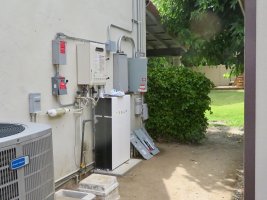

Last edited:
conarb
REGISTERED
It was left like this for hours with the workman sitting in a van at the street. He couldn't see it. Not only are the covers off but the door is open wide. There are small to medium size children living there. The workman told me that he alerted the housewife of the danger. He said that inspectors become upset if the covers aren't removed before they arrive. I'd like to be there for that. The damnable thing about this is that he was telling the truth about inspectors. If you are one of those inspectors, you shouldn't be....an inspector. A broom handle is the closest you should get to real construction.
Well Tiger here you go again, it's none of your business if the face's are left off the panels, as I've said before here most inspectors take a screw driver and remove them themselves, in many instances I tell them to forget about putting them back in, I'll have the electrician do it, and these are inspectors not allowed to walk roofs. Frankly I'd be more worried about those Tesla Power Packs blowing up.
Who’s business is it? Help me out with this. Tell me who I should contact. Or are you saying that I should ignore the danger?Well Tiger were you go again, it's none of your business if the face's are left off the panels, as I've said before here most inspectors take a screw driver and remove them themselves, in many instances I tell them to forget about putting them back in, I'll have the electrician do it, and these are inspectors not allowed to walk roofs. Frankly I'd be more worried about those Tesla Power Packs blowing up.
conarb
REGISTERED
Who’s business is it? Help me out with this. Tell me who I should contact. Or are you saying that I should ignore the danger?
To begin with it's none of your business, do like they do around here, open and close it yourself. Every hardwood floor layer I've ever had opens the main and attaches his alligator clips to run his sanders and polishers, they stay open for about one week in the average large new home. I asked one once why he didn't get pigtails that would plug into 30 amp dryer outlets or 50 amp range outlets, he said no that they always do it that way.
If you want to go beyond code enforcement in the interests of safety get a gun and handcuffs and arrest all of the illegals you find on jobsites.
it's none of your business if the face's are left off the panels
Actually it is. You could argue that the inspector should be opening their own panels, but safety is everyones business. Especially here, where you know small kids are around and the contractor is out of sight of the unsecured panels.
Lets take it to the next step. Kid finds the panel open, gets shocked. Parents sue everyone in sight including Ice, because he knew it was unsafe and did not take reasonable action to prevent the accident. It wasnt his fault the panels were left open, but once he knew they were not safe he becomes an accomplice by staying silent. And then i would go after the experienced professionals on the internet who said it was ok to leave them open.
conarb
REGISTERED
I don't know exactly where Tiger works but it's somewhere in the Los Angles basin, codes have driven housing costs so high that people are living on the streets, it's no reached crisis level and Tiger is concerned about panel faces,
I read an article the other day about city fees driving costs up:
¹ https://www.shtfplan.com/headline-n...erge-of-becoming-a-third-world-state_06262019
² http://charleshughsmith.blogspot.com/2019/06/local-government-is-engine-of-inflation.html
The city of Los Angeles is quickly descending into a cesspool of decay and disease. With bubonic plague now likely present amongst residents, the city and the state of California are on the verge of becoming a third-world hellscape. Some say that that’s already happened…
California’s burgeoning homeless camps are not the most hygienic places to live, obviously. And with the homeless population growing daily, the encampments are becoming more dangerous when it comes to crime and disease. Dr. Drew Pinsky said this month that there has been a total and complete breakdown of services in the city that has placed the population at risk of infection and other health-related issues.
“We have a complete breakdown of the basic needs of civilization in Los Angeles right now,” Pinsky told Fox News host Laura Ingraham. “We have the three prongs of airborne disease, tuberculosis is exploding, rodent-borne. We are one of the only cities in the country that doesn’t have a rodent control program, and sanitation has broken down.” Pinsky said bubonic plague, which is also known as the “Black Death,” a pandemic that killed off millions in the 14th century, is “likely” already present in Los Angeles. The plague is spread by infected fleas and exposure to bodily fluids from a dead plague-infected animal, with the bacteria entering through the skin and traveling to lymph nodes.
“This is unbelievable. I can’t believe I live in a city where this is not Third World. This is medieval,” Pinsky said, according to Fox News. “Third World countries are insulted if they are accused of being like this. No city on Earth tolerates this. The entire population is at risk.”¹
I read an article the other day about city fees driving costs up:
Allow me to explain another mechanism of rampant inflation triggered by local government. Cities and counties discovered a new revenue source in the late 20th century: real estate development fees. Building permits that once cost a few hundred dollars now cost thousands of dollars, and a host of new fees are now standard: sewer hookup fees, plan review fees, and development fees.
Then there are transfer fees for every sale of real estate, and mandated subsidized housing requirements for new apartment buildings: a percentage of the new apartments must be made available at below-market rents for qualified tenants. The cost of the subsidized units are borne by the owner/developer, not the taxpayer, so the subsidy in effect raises the market rents.
Partly as a result of these local government fees, the cost of building new apartments is very high. As a result, rents are also higher. If demand is strong, some desperate (or rich) tenants will pay the much higher rent.
The owners of existing buildings look at the high rents and their natural response is to raise their rents accordingly: the new market price for a one-bedroom apartment has been set by the high-cost new building, and rents throughout the city ratchet higher.
The same dynamic pushes commercial rents higher, too. The ground-floor commercial space in the new complex is rented out at sky-high rates to a corporate chain, and suddenly that insanely high rent is the new baseline for every equivalent space in the city.
When an old building is demolished to make way for a new apartment complex with ground-floor commercial spaces, the old tenants never return: they can no longer afford the rent. As I've discussed here before, this gentrification drives out diversity, leaving the city's commercial districts a homogenized, lifeless cluster of Corporate America outlets.
One reason the economy is so much more precarious than advertised is inflation has pushed households and small businesses to the edge--and one engine of that inflation is local government. This is not to dump on local government, which is facing essentially unlimited demands from the public for more services while mandated cost increases in government union employee wages and benefits ratchet higher.
Since personnel costs are 70+% of city and county budgets, those ever-increasing payroll, pension and benefits costs are the key driver of budgets expanding.
But local governments' ability to increase revenues are also essentially unlimited. There are all sorts of fees that can be created or increased if outright tax increases have been voted down by the public.
What amounts to blackmail is generally effective, however: if you want the giant potholes filled in your streets, you have to pass this municipal bond--or else.²
¹ https://www.shtfplan.com/headline-n...erge-of-becoming-a-third-world-state_06262019
² http://charleshughsmith.blogspot.com/2019/06/local-government-is-engine-of-inflation.html
fatboy
Administrator
Another thread spinning out of control........give it a rest CA!
To begin with it's none of your business, do like they do around here, open and close it yourself. Every hardwood floor layer I've ever had opens the main and attaches his alligator clips to run his sanders and polishers, they stay open for about one week in the average large new home. I asked one once why he didn't get pigtails that would plug into 30 amp dryer outlets or 50 amp range outlets, he said no that they always do it that way.
If you want to go beyond code enforcement in the interests of safety get a gun and handcuffs and arrest all of the illegals you find on jobsites.
I don’t expect everyone to understand.
I used to remove deadfront covers. I would rather not have the contractor present during the inspection. The problem with that is the dept. policy which has always been that we don’t remove anything. There are many new people performing inspections that shouldn’t remove covers. It is not fair to those people or contractors if I continue to remove deadfronts. So a couple years ago I quit doing it.
Last edited:
fatboy
Administrator
Not wanting to start anything, but I am confused, yes normal state of mind.
You can't remove covers due to policy...... you don't want the covers off before you get there, for safety........ but you don't want the contractor there when you are inspecting? How is this supposed to work? Please clarify.
You can't remove covers due to policy...... you don't want the covers off before you get there, for safety........ but you don't want the contractor there when you are inspecting? How is this supposed to work? Please clarify.
I used to remove the covers and the contractor was seldom there. That’s the way I like it. The way it is now, the contractor is there...sitting in a truck with the covers removed. That means that as I write the corrections I get a running diatribe complaining about the corrections. That takes time.....I don’t want to waste time. Especially with some worker that didn’t do the work and doesn’t understand the work. It is his job to be there and argue about everything.
Me: "The condensate pump can't be in the return air plenum"
Contractor: "It's not in the plenum"
Me: "Where is it"
Contractor: "That's not a condensate pump"
Me: "Alrighty then, what is it"
Contractor: "I don't know but it's not a pump in a plenum; that's not allowed"
Me: "This is going to require a semicolon"

Contractor: "It's not in the plenum"
Me: "Where is it"
Contractor: "That's not a condensate pump"
Me: "Alrighty then, what is it"
Contractor: "I don't know but it's not a pump in a plenum; that's not allowed"
Me: "This is going to require a semicolon"

Last edited:
ADAguy
REGISTERED
Why should they? Its the contractors responsibility to correct their "mistakes" (failure to comply) not yours.
Mr. Inspector
SAWHORSE
I asked my inspection company for PPE safety equipment and their answer is don't look at anything live.
ICE, do you use PPE safety equipment when inspection live parts?
ICE, do you use PPE safety equipment when inspection live parts?
No. I rarely get beyond 240 volt equipment. There have been a few 12,000 volt installations but I do not recall any inspections of live equipment and I wouldn't get within 20' of 12,000 volt, exposed live parts. Just looking at the insulation on a 12,000 volt conductor is evidence enough to stay far away from it.ICE, do you use PPE safety equipment when inspection live parts?
Last edited:
How did they get that attached to the pop-off?
In the front yard.

